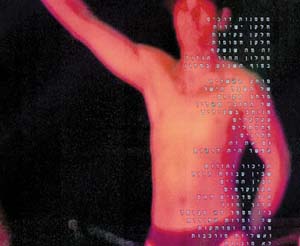The text rolling over the photograph is written in the form of a long poem intermittently interspersed with mundane and flowery language, interweaving narrative and lyrical, philosophic and simplistic speech. The poem is divided into eight chapters according to the secondary characters in the story. It follows a diamond dealer’s attempts to find a salesperson who will represent him in the United States (‘having become tired of traveling’) from among his friends and acquaintances from the kibbutz, the army, the teaching field, and the diamond exchange. His attempts become a quest, a root-seeking journey of account-settling, internal conflicts, struggles; a voyage into consciousness and knowledge, into the visible and the covert. Apparently, a journey doomed to fail.
Shooting was performed with a digital video camera hand-held like a still camera. The resulting sequence of images was cut in the editing room, broken into fragmentary, slow situations, reassembled along the textual sequence, and charged with new meanings and contexts. The photography has a way of its own to tell the story. It constructs the surrounding circle and creates tangential circles; it has no straight line of beginning, middle and end. At times it precedes the written text, conceals it, takes over; at others it follows the writing, attempting to reconstruct; and at yet other times it dissolves into the realm of abstract.
The soundtrack shifts between free, melancholic-jazzy or avant-garde music – an expressive statement in and of itself, and entirely neutral, local background noises or an imaginary impersonation.
The protagonists’ awareness of their condition, speech style, the way they look and the way they appear on camera ranges from high to absurd, from reference to indifference to the camera’s presence. The street, the surroundings, nature and the events intertwine in the story. The daily and political reality of time and place crops out of every frame and line. Nevertheless it is a highly personal epic.
Less Reading...
